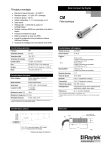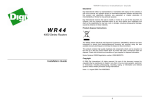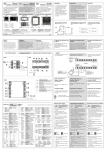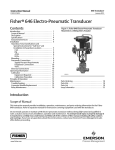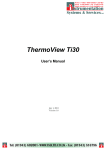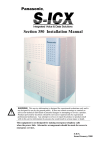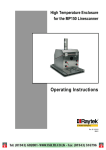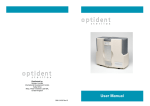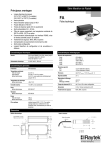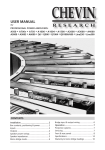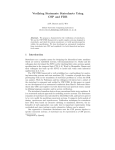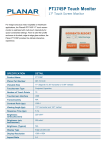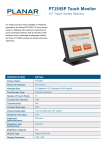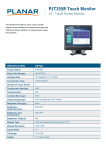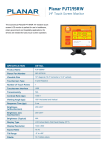Download Infrared Sensor Operating Instructions
Transcript
PO Box 1 Ilkley West Yorkshire Phone: 01943 602001 LS29 8EU Fax: 01943 816796 innstrumentation Website: www.issltd.co.uk Email: [email protected] Systems & Services Ltd CM Infrared Sensor Operating Instructions Rev. B i Tel: (01943) 602001- WWW.ISSLTD.CO.UK - Fax: (01943) 816796 i 06/2011 51101 The device complies with the requirements of the European Directives. EC – Directive 2004/108/EC (EMC) Contacts Raytek Corporation Worldwide Headquarters Santa Cruz, CA USA Tel: +1 800 227 – 8074 (USA and Canada only) +1 831 458 – 3900 Fax: +1 831 458 – 1239 [email protected] European Headquarters Berlin, Germany Tel: +49 30 4 78 00 80 France United Kingdom [email protected] [email protected] [email protected] Fluke Service Center Beijing, China Tel: +86 10 6438 4691 [email protected] Internet: http://www.raytek.com/ Thank you for purchasing this Raytek product. Register today at www.raytek.com/register to receive the latest updates, enhancements and software upgrades! © Raytek Corporation. Raytek and the Raytek Logo are registered trademarks of Raytek Corporation. All rights reserved. Specifications subject to change without notice. WARRANTY The manufacturer warrants this product to be free from defects in material and workmanship under normal use and service for a period of two years from date of purchase except as hereinafter provided. This warranty extends only to the original purchaser. This warranty shall not apply to fuses or batteries. Factory calibration is warranted for a period of one year. The warranty shall not apply to any product that has been subject to misuse, neglect, accident, or abnormal conditions of operation or storage. Should the manufacturer be unable to repair or replace the product within a reasonable amount of time, purchaser’s exclusive remedy shall be a refund of the purchase price upon return of the product. In the event of failure of a product covered by this warranty, the manufacturer will repair the instrument when it is returned by the purchaser, freight prepaid, to an authorized Service Facility within the applicable warranty period, provided the manufacturer’s examination discloses to its satisfaction that the product was defective. The manufacturer may, at its option, replace the product in lieu of repair. With regard to any covered product returned within the applicable warranty period, repairs or replacement will be made without charge and with return freight paid by the manufacturer, unless the failure was caused by misuse, neglect, accident, or abnormal conditions of operation or storage, in which case repairs will be billed at a reasonable cost. In such a case, an estimate will be submitted before work is started, if requested. THE FOREGOING WARRANTY IS IN LIEU OF ALL OTHER WARRANTIES, EXPRESSED OR IMPLIED, INCLUDING BUT NOT LIMITED TO ANY IMPLIED WARRANTY OF MERCHANTABILITY, FITNESS, OR ADEQUACY FOR ANY PARTICULAR PURPOSE OR USE. THE MANUFACTURER SHALL NOT BE LIABLE FOR ANY SPECIAL, INCIDENTAL OR CONSEQUENTIAL DAMAGES, WHETHER IN CONTRACT, TORT, OR OTHERWISE. Content 1 Safety Instructions ................................................................................................. 8 2 Description ............................................................................................................ 10 3 Technical Data ...................................................................................................... 11 3.1 PARAMETERS .................................................................................................... 11 3.2 OPTICAL DIAGRAM.......................................................................................... 13 3.3 SCOPE OF DELIVERY ......................................................................................... 14 4 Basics ...................................................................................................................... 15 4.1 MEASUREMENT OF INFRARED TEMPERATURE ................................................ 15 4.2 DISTANCE AND SPOT SIZE ............................................................................... 16 4.3 AMBIENT TEMPERATURE ................................................................................. 16 4.4 ATMOSPHERIC QUALITY .................................................................................. 16 4.5 ELECTRICAL INTERFERENCE ............................................................................ 17 4.6 EMISSIVITY OF TARGET OBJECT ....................................................................... 17 5 Install and Operation .......................................................................................... 18 5.1 DIMENSIONS OF SENSOR .................................................................................. 18 5.2 MECHANICAL INSTALLATION ......................................................................... 19 5.3 CABLE ............................................................................................................... 19 5.4 WIRE CONNECTION ......................................................................................... 20 5.4.1 Analog output ...........................................................................................20 5.4.2 Alarm output.............................................................................................20 5.5 LED INDICATOR AND BLINK MODE ................................................................. 21 6 Software ................................................................................................................. 22 7 Accessories ............................................................................................................ 23 7.1 OVERVIEW ........................................................................................................ 23 7.2 FIXED MOUNTING BRACKET............................................................................ 24 7.3 ADJUSTABLE MOUNTING BRACKET ................................................................ 25 7.4 AIR PURGE COLLAR ......................................................................................... 26 7.5 RIGHT ANGLE MIRROR .................................................................................... 27 7.6 PROTECTIVE WINDOW ..................................................................................... 28 8 Programming ........................................................................................................ 29 8.1 GENERAL COMMAND STRUCTURE .................................................................. 29 8.2 DEVICE SETUP .................................................................................................. 30 8.2.1 Temperature Calculation ...........................................................................30 8.2.2 Post Processing .........................................................................................30 8.3 DYNAMIC DATA...............................................................................................30 8.4 DEVICE CONTROL ............................................................................................31 8.4.1 Output for target temperature .................................................................. 31 8.4.2 Analog output, scaling ............................................................................. 31 8.4.3 Alarm output ............................................................................................ 31 8.4.4 Factory default values ............................................................................... 32 9 Maintenance ..........................................................................................................33 9.1 TROUBLESHOOTING MINOR PROBLEMS ..........................................................33 9.2 ERROR CODES...................................................................................................34 9.3 AUTOMATIC ERROR INDICATION ....................................................................34 9.4 CLEANING THE LENS .......................................................................................34 10 Appendix .............................................................................................................36 10.1 DETERMINATION OF EMISSIVITY....................................................................36 10.2 TYPICAL EMISSIVITY VALUES.........................................................................36 10.3 COMMAND SET ..............................................................................................43 Safety Instructions 1 Safety Instructions This document contains important information, which should be kept at all times with the instrument during its operational life. Other users of this instrument should be given these instructions with the instrument. Eventual updates to this information must be added to the original document. The instrument can only be operated by trained personnel in accordance with these instructions and local safety regulations. Acceptable Operation This instrument is intended only for the measurement of temperature. The instrument is appropriate for continuous use. The instrument operates reliably in demanding conditions, such as in high environmental temperatures, as long as the documented technical specifications for all instrument components are adhered to. Compliance with the operating instructions is necessary to ensure the expected results. Unacceptable Operation The instrument should not be used for medical diagnosis. Replacement Parts and Accessories Use only original parts and accessories approved by the manufacturer. The use of other products can compromise the operational safety and functionality of the instrument. Instrument Disposal Disposal of old instruments should be handled according to professional and environmental regulations as electronic waste. CM Rev. B 06/2011 8 Safety Instructions Operating Instructions The following symbols are used to highlight essential safety information in the operation instructions: Helpful information regarding the optimal use of the instrument. Warnings concerning operation to avoid instrument damage and personal injury. Pay particular attention to the following safety instructions. Incorrect use of 110 / 230 V electrical systems can result in electrical hazards and personal injury. All instrument parts supplied with electricity must be covered to prevent physical contact and other hazards at all times. 9 Rev. B 06/2011 CM Description 2 Description The CM miniature infrared sensors are high performance noncontact infrared temperature measurement systems. They measure the amount of energy emitted from an object accurately and repeatedly and convert the energy into temperature signal. The following analog outputs are available by different model: 0 to 5 Volt J thermocouple K thermocouple The LED on the back of CM shows the status of units. CM Rev. B 06/2011 10 Technical Data 3 Technical Data 3.1 Parameters Temperature range -20 to 500°C (-4 to 932°F) Spectral response 8 to 14 μm Thermal Parameters Accuracy1 (Digital and Voltage) ± 1.5% of reading or ± 2°C2 whichever is greater Accuracy3 (TC) ± 1.5% of reading ±2°C or ± 4°C4 whichever is greater Repeatability (Digital and Voltage) ± 0.5% of reading or ± 1°C whichever is greater Repeatability (TC) ± 0.5% of reading ± 1°C or ± 2°C whichever is greater Response time (95%) 150 ms Temperature resolution 0.1°C (0.2°F) Emissivity 0.100 to 1.100 (software controlled) Transmissivity 0.100 to 1.000 (software controlled) Electrical Parameters Power 24 VDC ± 20% @ 20 mA Analog Output 0 to 5 V or TCJ or TCK output Digital Output Two-way RS232 digital output 9600 baud, 8 data bits, 1 stop bit, no parity, no flow control 1 2 3 4 for ambient temperature 23°C (73°F) ± 5 K , e = 0.95 and calibration geometry ± 3.5°C for Tmeas < 0°C (32°F) for ambient temperature 23°C (73°F) ± 5 K , e = 0.95 and calibration geometry ± 5.5°C for Tmeas < 0°C (32°F) 11 Rev. B 06/2011 CM Technical Data Alarm Output Transistor, 24 VDC @ 20 mA RS232 TxD and Alarm output share one single wire. Either can be selected by DataTemp software or ASCII command! General Parameters Environmental rating IP65 (NEMA-4x) Ambient operating range -10 to 70°C (14 to 158°F) Storage temperature -20 to 85°C (-4 to 185°F) Dimensions Ø ¾”, length: 94 mm (3.7 in) Weight < 200 g (7.1 oz) CM Rev. B 06/2011 12 Technical Data 3.2 Optical Diagram The optical diagrams indicate the target spot diameter at any given distance between the target object and the sensing head. All target spot sizes indicated in the optical diagrams are based on 90% energy. Optical resolution 13:1 @ 150 mm (90% energy) Figure 1:Optical diagram Calculating the Target Spot Size To calculate the target spot size from two known points within an optical diagram the following formula can be used: Sx = unknown diameter of target spot Sn = smallest known diameter of target spot Sf = greatest known diameter of target spot Dx = distance to unknown target spot Dn = distance to smaller known target spot Df = distance to greater known target spot 13 Rev. B 06/2011 CM Technical Data 3.3 Scope of Delivery Sensor 2 mounting nuts Support software CD Quickstart Guide CM Rev. B 06/2011 14 Basics 4 Basics 4.1 Measurement of Infrared Temperature Everything emits an amount of infrared radiation according to its surface temperature. The intensity of the infrared radiation changes according to the temperature of the object. Depending on the material and surface properties, the emitted radiation lies in a wavelength spectrum of approximately 1 to 20 μm. The intensity of the infrared radiation (”heat radiation”) is dependent on the material. For many substances this material-dependent constant is known. It is referred in Section 10.2 Typical Emissivity Values on page 36. Infrared thermometers are optical-electronic sensors. These sensors are able to detect ”radiation of heat”. Infrared thermometers are made up of a lens, a spectral filter, a sensor, and an electronic signal-processing unit. The task of the spectral filter is to select the wavelength spectrum of interest. The sensor converts the infrared radiation into an electrical parameter. The connected electronics generate electrical signals for further analysis. As the intensity of the emitted infrared radiation is dependent on the material, the required emissivity can be selected on the sensor. The biggest advantage of the infrared thermometer is its ability to measure in the absence of contact. Consequently, surface temperatures of moving or hard to reach objects can easily be measured. 15 Rev. B 06/2011 CM Basics 4.2 Distance and Spot Size The desired spot size on the target will determine the maximum measurement distance and the necessary focus length of the optical module. To avoid erroneous readings the target spot size must contain the entire field of view of the sensor. Consequently, the sensor must be positioned so the field of view is the same as or smaller than the desired target size. Best Good Incorrect Target greater than spot size Target equal to spot size Background Target smaller than spot size Figure 2: Proper Sensor Placement 4.3 Ambient Temperature The sensing head should work under ambient operating range in accordance to section 3.1 Parameters, page 11. 4.4 Atmospheric Quality In order to prevent damage to the lens and erroneous readings, the lens should always be protected from dust, smoke, fumes, and other contaminants. For this purpose an air purge collar is available. You should only use oil free, clean “instrument“ air. CM Rev. B 06/2011 16 Basics 4.5 Electrical Interference To minimize electrical or electromagnetic interference, follow these precautions: Mount the sensor as far away as possible from possible sources of interference such as motorized equipment producing large step load changes. Ensure a fully insulated installation of the sensor (Avoid ground loops!). Make sure the shield wire in the sensor cable is earth grounded at one location. 4.6 Emissivity of Target Object Determine the emissivity of the target object as described in appendix 10.1 Determination of Emissivity. If emissivity is low, measured results could be falsified by interfering infrared radiation from background objects (such as heating systems, flames, fireclay bricks, etc. close beside or behind the target object). This type of problem can occur when measuring reflecting surfaces and very thin materials such as plastic films and glass. This measuring error when measuring objects with low emissivity can be reduced to a minimum if particular care is taken during installation, and the sensing head is shielded from these reflecting radiation sources. 17 Rev. B 06/2011 CM Install and Operation 5 Install and Operation 5.1 Dimensions of Sensor All sensors and accessories are supplied with 3/4-16 UNF-2A or M18x1 thread. Figure 3: Dimensions of sensor CM Rev. B 06/2011 18 Install and Operation 5.2 Mechanical Installation All sensors come with a 1.0 m (3.3 ft) cable or 3.0 m (9.8 ft) and 2 mounting nuts. You can mount the sensor in brackets or cutouts of your own design, or you can use the mounting bracket accessories. Figure 4: Sensor with fixed mounting bracket 5.3 Cable The color code of the cable and 6 conductors are shown in the following table: 8 1 2 3 Outer Jacket Power + Power -** RxD J brown K yellow 0 to 5 V grey orange black blue 4 TxD/ Alarm violet 5 TC+/ mV+ 6 TC-/ mV- white red yellow red yellow brown 7 Shield ** Die RS232’s Ground must be connected to Power- Table 1: Sensor Wiring Color Code 19 Rev. B 06/2011 CM Install and Operation 5.4 Wire Connection Figure 5: Connection diagram 5.4.1 Analog output There are 3 models available: 0 to 5 V, TCJ, TCK. Minimum load impedance for 0 to 5 V output should be 50 kΩ. Inner impedance of TC output circuit is 100 Ω. 5.4.2 Alarm output RS232 TxD and alarm output share one single wire. Either can be selected by the DataTemp software or RS232 command. When alarm mode is active, the CM can receive command from a PC via RS232, but can’t respond to the PC. RS232 TxD can work normally after the alarm output is switched off by command K=0, see Section 10.3 Command Set. If unit is set by DataTemp software, alarm output is valid only after the unit is restarted. CM Rev. B 06/2011 20 Install and Operation 5.5 LED indicator and blink mode You can easily find the unit health status by the following LED blink mode: status LED-blink LED-status normal slow blink 1 alarm fast blink ○ ○ ○ ○ ○ ○ ○ ○ out of range double blink ○ ○○○○○ ○ ○○○○○ unstable* slow blink 2 ○○○ ○○○ ○○○ ○○○ alarm fault** always lighting ○ * unstable is typically caused by head ambient temperature fluctuations due to initial warm up or thermal shock situations. ** alarm fault indicates the input of sensor’s alarm port is over current. Table 2: LED blink mode 21 Rev. B 06/2011 CM Software 6 Software Raytek DataTemp Multidrop software allows the configuration and monitoring of CM sensor operating parameters, such as: Emissivity Transmissivity Averaging Peak hold Valley hold Temperature scale of analog output Alarm temperature value 1 point field calibration offset Alarm output Refer to DataTemp software online help for more detail. Notes for CM sensors: 1. 2. CM Use the Temperature unit in Degree C for field calibration, if in Degree F, there is no effect. CM shares the alarm line with the RS232 TxD and the alarm function will be temporarily turned off and changed to RS232 mode when connecting to the DataTemp software. After re-powering the sensor without connecting to the DataTemp software, the alarm mode will function normally. Rev. B 06/2011 22 Accessories 7 Accessories 7.1 Overview Fixed Mounting Bracket XXXCIACFB Adjustable Mounting Bracket XXXCIADJB Air Purge Collar XXXCMACAP metrical: XXXCMACAPM Right Angle Mirror XXXCMACRA metrical: XXXCMACRAM Protective Window XXXCMACPW metrical: XXXCMACPWM Adjustable Mounting Bracket Air Purge Collar Fixed Mounting Bracket Protective Window Right Angle Mirror Figure 6: Overview of available accessories 23 Rev. B 06/2011 CM Accessories 7.2 Fixed Mounting Bracket Figure 7: Dimensions of Fixed Mounting Bracket CM Rev. B 06/2011 24 Accessories 7.3 Adjustable Mounting Bracket Figure 8: Dimensions of Adjustable Mounting Bracket 25 Rev. B 06/2011 CM Accessories 7.4 Air Purge Collar The Air Purge Collar is used to keep dust, moisture, airborne particles, and vapors away from the lens. It can be mounted before or after the bracket. It has the push-in fitting. A 4 mm (0.16 in) outside diameter plastic tubing is recommended to connect the fitting. Air flows into the fitting and out the front aperture. The pressure of air should be 0.6 to 1 bar (8.7 to 15 PSI). Clean, oil free air is recommended. Figure 9: Dimensions of Air Purge Collar CM Rev. B 06/2011 26 Accessories 7.5 Right Angle Mirror The Right Angle Mirror is used to turn the field of view by 90° against the sensor axis. It is recommended when space limitations or excessive radiation do not allow for direct alignment of the sensor to the target. The mirror must be installed after the bracket and after the Air Purge Collar and screwed in fully. In dusty or contaminated environments, air purging is required to keep the mirror surface clean. Figure 10: Dimension of Right Angle Mirror When using the Right Angle Mirror, adjust the emissivity or transmissivity settings downward by 5%. For example, for an object with an emissivity of 0.65, you adjust the value down to 0.62. Or, you can keep the emissivity 0.65 and adjust the transmissivity from 1.0 to 0.95. This correction accounts for energy losses in the mirror. 27 Rev. B 06/2011 CM Accessories 7.6 Protective Window The protective window comes with Silicon as window material. Determination of transmissivity of an unknown protective window: If transmissivity of the measuring screen is not indicated on the data sheet, you can also determine the transmissivity yourself. Please proceed as follows: 1. Measure the temperature of the target object with the sensing head, without using the protective window. Note correct setting of emissivity. 2. Insert the protective window in the sensing head. 3. Adjust the transmissivity in the software until the same temperature is displayed, as it was determined without the protective window. CM Rev. B 06/2011 28 Programming 8 Programming 8.1 General Command Structure Requesting a parameter ?E<CR> “?“ is the command for “Request“ “E“ is the parameter requested <CR> (carriage return, 0Dh) is closing the request. Remark: It is possible to close with <CR> <LF> (0Dh 0Ah), but <LF> (0Ah) is not necessary. Setting a parameter (Poll Mode) The parameter will be stored into the device flash memory. E=0.975<CR> “E“ is the parameter to be set “=“ is the command for “set a parameter“ “0.975“ is the value for the parameter <CR> (carriage return, 0Dh) is closing the request Remark: It is possible to close with <CR> <LF> (0Dh 0Ah), but <LF> (0Ah) is not necessary. Setting a parameter without writing it into the device flash memory. This function is for test purposes only. E#0.975<CR> “E“ is the parameter to be set “#“ is the command for “set parameter without writing it into the Flash“ “0.975“ is the value for the parameter <CR> (carriage return, 0Dh) is closing the request. Remark: It is possible to close with <CR> <LF> (0Dh 0Ah), but <LF> (0Ah) is not necessary. Device response format: !E0.975<CR><LF> “!“ is the parameter for “Answer“ “E“ is the Parameter “0.975“ is the value for the parameter 29 Rev. B 06/2011 CM Programming <CR> <LF> (0Dh 0Ah) is closing the answer. Error message: *Syntax Error “*“ is the character for “Error“. 8.2 Device Setup 8.2.1 Temperature Calculation U=C E=0.950 XG=1.000 Physical Unit for the temperature value Emissivity setting Setting for transmission For the calculation of the temperature value, it is possible to set an offset (relative number to be added to the temperature value). DO=-0.3 Offset adjustment -0.3 for the temperature signal 8.2.2 Post Processing The following parameters can be set to determine the post-processing mode P=5 F=12.5 G=10 maximum hold, hold time: 5 sec minimum hold, hold time: 12.5 sec averaging, average time (90%): 10 sec 8.3 Dynamic Data To request the dynamic data, the following commands are available: ?T ?I ?XJ ?Q Target temperature Detector ambient temperature Temperature of Thermocouple cold end (only valid for TC) energy value of the target temperature To check for resets (e.g. power shut down) use the command XI. Notice, after a reset the unit is re- initialized. ?XI !XI0 !XI1 asks for the reset status no reset occurred a reset occurred, new initialization of the unit XI=0 sets the reset status back to 0 CM Rev. B 06/2011 30 Programming 8.4 Device Control 8.4.1 Output for target temperature The output can provide a predefined value of full analog range when signal output is 0 … 5 V. ?XO O=25 O=255 Request for the output mode output of a constant voltage at 1.25 V (25% of 0 … 5 V) switches back to the temperature controlled output 8.4.2 Analog output, scaling According to the temperature range of the model, it is possible to set the maximum voltage value according to a temperature value (e.g., the maximum voltage 5 V shall represent 200°C). The same setting is possible for the minimum value. H=500 L=0 the maximum voltage value is set to 500°C the minimum voltage value is set to 0°C You cannot set these values for thermocouple output. The minimum span between the maximum / minimum settings is 20 K. 8.4.3 Alarm output The alarm output can be set to N.C. (relay contacts are closed while in home position) or N.O. (relay contacts are open while in home position). The alarm output can be activated by: Internal sensing head temperature Target temperature K=0 K=4 alarm output disabled Sensor head ambient temperature lower than threshold, relay N.O. K= 2, XS=125.3 Target temperature lower than threshold, relay N.O., threshold setting to 125.3℃(if U=C is set) 31 Rev. B 06/2011 CM Programming 8.4.4 Factory default values It is possible to reset the unit to the original factory default values. XF CM factory default values will be set Rev. B 06/2011 32 Maintenance 9 Maintenance Our customer service representatives are always at your disposal for any questions you might have. This service includes any support regarding the proper application of your infrared measuring system, calibration or the solution to customer-specific solutions as well as repair. In many cases your problems will be application-specific and can possibly be solved over the telephone. So, if you need to return equipment to us, please contact our Service Department before doing so. See phone and fax numbers at the beginning of this document. 9.1 Troubleshooting Minor Problems Symptom No Output Possible Cause Solution Cable disconnected Check Cable Connections Erroneous Cable damaged Temperature Check Cable Erroneous Field of View Obstructed Temperature Remove the Obstruction Erroneous Lens Dirty Temperature Clean the Lens Erroneous Wrong Emissivity Setting Temperature Correct the Setting (Appendix) Temperature Wrong Signal Processing Fluctuates Correct Peak, Valley, or Average Settings Temperature Sensor not grounded Fluctuates Check Wiring/Grounding Table 3: Troubleshooting 33 Rev. B 06/2011 CM Maintenance 9.2 Error Codes Output Error Code Description T>>>>>> Temperature over range T<<<<<< Temperature under range Table 4: Error Codes (via RS232) 9.3 Automatic Error Indication The automatic error indication (alarm output) shall warn the user and guarantee a secure output in the event of a system error. In the first place, however, its task is to switch the system off in case of a faulty setup or a defect in the sensing head or in the electronic circuits. Never rely exclusively on the automatic error indication when monitoring critical heating processes. It is strongly recommended to take additional safety measures. 9.4 Cleaning the Lens Care should be taken to keep the lens clean. Any foreign matter on the lens will affect the accuracy of the measurements. Be sure to take care when cleaning the lens. Please observe the following: 1. 2. 3. Blow off loose particles with clean air. Gently brush off remaining particles with a soft camel hair brush. To remove any severe contamination, use a clean, soft cloth dampened with distilled water. In any case, do not scratch the lens surface! For fingerprints or other grease, use any of the following: Denatured alcohol Ethanol Kodak lens cleaner CM Rev. B 06/2011 34 Maintenance Apply any of the above to the lens. Wipe gently with a clean, soft cloth until you see colors on the lens surface, then allow to air dry. Never wipe the surface dry - this may scratch the surface. If the lens is contaminated with silicones (e.g. from hand creams), clean it carefully using Hexane. Allow the lens to air dry. Do not use any ammonia or any cleaners containing ammonia to clean the lens. This may result in permanent damage to the lens’ surface. 35 Rev. B 06/2011 CM Appendix 10 Appendix 10.1 Determination of Emissivity Emissivity is a measure of an object’s ability to absorb and emit infrared energy. It can have a value between 0 and 1.0. For example, a mirror has an emissivity of 0.1, while the so-called “Blackbody“ reaches an emissivity value of 1.0. If a higher than actual emissivity value is set, the output will read low, provided the target temperature is above its ambient temperature. For example, if you have set 0.95 and the actual emissivity is 0.9, the temperature reading will be lower than the true temperature. An object’s emissivity can be determined by one of the following methods: 1. Determine the actual temperature of the material using an RTD (PT100), a thermocouple, or any other suitable method. Next, measure the object’s temperature and adjust emissivity setting until the correct temperature value is reached. This is the emissivity for the measured material. 2. For relatively low temperatures (up to 260℃, 500℉), place a plastic sticker on the object to be measured. This sticker should be large enough to cover the target spot. Next, measure the sticker’s temperature using an 3. emissivity setting of 0.95. Finally, measure the temperature of an adjacent area on the object and adjust the emissivity setting until the same temperature is reached. This is the emissivity for the measured material. If possible, apply flat black paint to a portion of the surface of the object. The emissivity of the paint must be above 0.98. Next, measure the temperature of the painted area using an emissivity setting of 0.98. Finally, measure the temperature of an adjacent area on the object and adjust the emissivity until the same temperature is reached. This is the emissivity for the measured material. 10.2 Typical Emissivity Values The following table provides a brief reference guide for determining emissivity and can be used when one of the above methods is not practical. CM Rev. B 06/2011 36 Appendix Emissivity values shown in the table are only approximate, since several parameters may affect the emissivity of a material. These include the following: 1. 2. 3. 4. 5. 6. 7. 37 Temperature Angle of measurement Geometry (plane, concave, convex) Thickness Surface quality (polished, rough, oxidized, sandblasted) Spectral range of measurement Transmissivity (e.g. thin films plastics) Rev. B 06/2011 CM Appendix METAL Material Emissivity/ Spectral range 3.9 µm Aluminum Unoxidized Oxidized Alloy A3003, Oxidized Roughened Polished 8 – 14 µm 0.02-0.1 0.2-0.4 0.3 0.1-0.3 0.02-0.1 Lead Polished Rough Oxidized 0.05-0.1 0.4 0.2-0.6 0.02-0.2 Chromium Iron Oxidized Unoxidized Rusted Molten Iron, Cast Oxidized Unoxidized Molten Iron, Wrought Dull Gold Haynes Alloy Inconel Oxidized Sandblasted Electropolished Copper Polished aufgeraut CM 5 µm 0.5-0.9 0.05-0.2 0.5-0.7 — 0.6-0.95 0.2 0.2-0.3 0.9 0.01-0.1 0.3-0.8 0.7-0.95 0.3-0.6 0.15 0.03 0.05-0.1 Rev. B 06/2011 38 Appendix METAL Material Emissivity/ Spectral range 3.9 µm oxidiert Magnesium Brass Polished Burnished Oxidized Molybdenum Oxidized Unoxidized Monel (Ni-Cu) Nickel Oxidized Electrolytic Platinum Black Mercury Silver Steel Cold-Rolled Ground Sheet Polished Sheet Molten Oxidized Stainless Roughened Oxidized Titanium Polished Oxidized Tungsten Polished Zinc Oxidized 39 5 µm 8 – 14 µm 0.4-0.8 0.02-0.1 0.01-0.05 0.3 0.5 0.2-0.6 0.1 0.1-0.14 0.2-0.5 0.05-0.15 0.9 0.05-0.15 0.02 0.7-0.9 0.4-0.6 0.1 — 0.7-0.9 0.1-0.8 0.05-0.1 0.4-0.8 0.05-0.2 0.5-0.6 0.03 0.03-0.1 0.1 Rev. B 06/2011 CM Appendix METAL Material Emissivity/ Spectral range 3.9 µm 5 µm Polished Tin (Unoxidized) 8 – 14 µm 0.02 0.05 Table 5: Typical Emissivity Values CM Rev. B 06/2011 40 Appendix NON-METAL MATERIAL Material Emissivity/ Spectral range 3.9 µm 5 µm Asbestos Asphalt Basalt Concrete Ice Paint (non-al.) Gypsum Glass Plate „Gob“ Rubber Wood, Natural Limestone Karborund Ceramic Gravel Carbon Unoxidized Graphite Clay Paper (any color) Plastic (opaque, over 20 mils) Salz Sand Snow Cloth Water 8 – 14 µm 0.95 0.95 0.7 0.95 0.98 0.9-0.95 0.8-0.95 0.85 — 0.95 0.9-0.95 0.98 0.9 0.95 0.95 0.8-0.9 0.7-0.8 0.95 0.95 0.95 0.9-0.98 0.9 0.9 0.95 0.93 Table 6: Typical Emissivity Values Non- Metal Material 41 Rev. B 06/2011 CM Appendix To optimize surface temperature measurements, consider the following guidelines: Determine the object emissivity using the instrument that will also be used for the measurements. Avoid reflections by shielding the object from surrounding temperature sources. For higher temperature objects, use instruments with the shortest wavelength possible. For translucent materials, such as plastic foils or glass, assure that the background is uniform and lower in temperature than the object. You should place the sensor perpendicular to the object’s surface (if possible) or at any angle from the target up to 30°! CM Rev. B 06/2011 42 Appendix 10.3 Command Set P ... Poll, B ... Burst, S ... Set, N ... Notification FORMATSET Description Char Format P S Example Poll parameter ? ?X ?T Set parameter = X=... E=0.85 Set without Save # X# E#0.85 FORMAT RESPONSE Description Char Format P S Example Acknowledge ! !XXX !T020.0 Error message * *Syntax error COMMAND LIST Description Device adjustment gain** Device adjustment offset ** Device special Info. Char Format P S Legal values Factory default DG n.nnnn 0.8000 … 1.2000 1 DO nn.n -20.0 … +20.0°C 0 DS XXX z.B. !DSRAY DSRAY 0.95 Emissivity internal E n.nnn Valley hold time F nnn.n 0.100 … 1.100 0.000 … 998.9 s (999 = infinite) Average time G nnn.n 0.100 ... 999 s 0 Top of mV range H nnnn.n 0 … 500°C 500 Sensor/head ambient I nnn.n Relay alarm output control K n In current scale (°C/°F) 0=Alarm Off 1=Alarm On 2= Target, normal open 3= Target, normal close 4= Head, normal open 5= Head, normal close 6= Over current protect* Bottom of mV range L nnnn.n Output voltage*** O nnn 43 -20 … 480°C 0-100=% of full range 255=controlled by unit Rev. B 06/2011 0 -20 CM Appendix 0.100~998.9 secs (999=infinite) Peak hold time P nnn.n Power Q nnnnn Target temperature T nnnn.n In current scale (°C / °F) Temperature unit Device bottom range limit Restore factory defaults U X C/F C XB nnnn.n -20°C -20 Transmission XG n.nnn XF 0.100 Device high range limit XH nnnn.n Sensor initialization TC cold end temperature Analog output mode 0 XI n XJ nnn.n XO … 1.000 500°C 1 = after RESET, 0 = if XI = 0 1 500 In current scale (°C / °F) 1 = 0 ... 5 V 2 = TCJ 3 = TCK n FW revision Setpoint/Relay function XR e.g. 1.000 XS nnnn.n -17.2 … 497.2°C Unit identification XU nnnn.n e.g.!CMLTV 497.2 Serial number XV e.g. 00012345 * Poll only ** only available when unit is in °C mode *** only available when unit is in mV mode Table 7: Command set CM Rev. B 06/2011 44












































